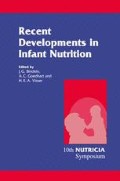Abstract
This discussion will review three somewhat unresolved areas of iron nutrition that are becoming clarified as a result of recent studies. The first is the optimal level of iron fortification for infant formula used by term infants. The studies described favour the use of formulas with intermediate levels of added iron (6–8 mg/l) rather than the high levels (12–13 mg/l) that are widely used in the United States. The second topic of preventing iron deficiency in low birth weight infants emphasizes the importance of starting with premature formulas containing 12–13 mg iron/l or administering 2 mg/kg/day of medicinal iron by about 1 month of age. Very low birth weight infants require as much as 4 mg/kg/day of medicinal iron and have increased iron needs well into their second year. Because of their unusually high risk of developing iron deficiency anaemia, low birth weight infants need to be monitored for anaemia and iron deficiency at regular intervals. Infants breast-fed for more than 6 months are likewise at substantial risk of developing iron deficiency anaemia, even with a diet of iron- and ascorbic-acid-rich foods. Special, iron- and ascorbic-acid-fortified meat and cereal foods used after 4–6 months can be effective. Where these are not available, an alternative is the administration of medicinal iron at a dose of 1 mg/kg/day to a maximum of 15 mg.
Access this chapter
Tax calculation will be finalised at checkout
Purchases are for personal use only
Preview
Unable to display preview. Download preview PDF.
References
Walter T, De Andraca I, Chadud P, Perales CG 1989 Iron deficiency anemia: adverse effects on infant psychomotor development. Pediatrics 84:7–17
Lozoff B, Jimenez E, Wolf AW 1991 Long-term developmental outcome of infants with iron deficiency. N Engl J Med 325:687–694
Idjradinata P, Pollitt E 1993 Reversal of developmental delays in iron-deficient anaemic infants treated with iron. Lancet 331:1–4
Yip R, Binkin NJ, Fleshood L, Trowbridge FL 1987 Declining prevalence of anemia among low-income children in the United States. JAMA 258:1619–1623
Yip R, Walsh KM, Goldfarb MG, Binkin NJ 1987 Declining prevalence of anemia in childhood in a middle-class setting: a pediatric success story? Pediatrics 80:330–334
Pizarro F, Yip R, Dallman PR, Olivares M, Hertrampf E, Walter T 1991 Iron status with different infant feeding regimens: relevance to screening and prevention of iron deficiency. J Pediatr 118:687–692
Dallman PR 1989 Upper limits of iron in infant formulas. J Nutr 119:1852–1855
Gorton MK, Cross ER 1964 Iron metabolism in premature infants. II. Prevention of iron deficiency. J Pediatr 64:509–520
Saarinen UM, Siimes MA 1977 Iron absorption from infant milk formula and the optimal level of iron supplementation. Acta Paediatr Scand 66:719–722
Heinrich HC, Gabbe EE, Whang DH 1969 Die Dosisabhängigkeit der intestinalen Eisenresorption bei Menschen mit normalen Eisenreserven und Personen mit prälatentem/latentem Eisenmangel. Z Naturforsch 24b: 1301–1310
Hahn PF, Carothers EL, Darby WJ, Martin M, Sheppard CW, Cannon RO, Beam AS, Densen PM, Peterson JC, McClellan GS 1951 Iron metabolism in human pregnancy as studied with the radioactive isotope, Fe59. Am J Obstet Gynecol 61:477–486
Haschke F, Vanura H, Male C, Owen G, Pietschnig B, Schuster E, Kroback E, Huemer C 1993 Iron nutrition and growth of breast- and formula-fed infants during the first 9 months of life. J Pediatr Gastroenterol Nutr 16:151–156
Lönnerdal B, Hernell O 1994 Iron, zinc, copper and selenium status of breast-fed infants and infants fed trace element fortified milk-based infant formula. Acta Paediatr 83:367–373
Dallman PR 1992 Changing iron needs from birth through adolescence. In: Fomon S J, Zlotkin S (eds) Nutritional Anemias. Nestlé Nutrition Workshop Series, Vol 30, Nestec Ltd, Vevey/Raven Press Ltd, New York, pp 29–38
National Research Council 1989 Recommended Dietary Allowances, 10th edn. Food and Nutrition Board, National Academy Press, Washington, DC
Dweck HS, Finberg L, Holmes F, Reynolds JD and American Academy of Pediatrics, Committee on Nutrition 1985 Nutritional needs of low-birth-infants. Pediatrics 75:976–985
Siimes MA, Järvenpää AL 1982 Prevention of anemia and iron deficiency in very low-birth-weight infants. J Pediatr 101:277–280
Lundström U, Siimes MA, Dallman PR 1977 At what age does iron supplementation become necessary in low-birth-infants? J Pediatr 91:878–883
Hall RT, Wheeler RE, Benson F, Harris G, Rippetoe L 1993 Feeding iron-fortified premature formula during initial hospitalization to infants less than 1800 grams birth weight. Pediatrics 92: 409–414
Friel JK, Andrews WL, Mathew JD, Long DR, Cornel AM, Cox M, Skinner CT 1990 Iron status of very-low-birth-infants during the first 15 months of infancy. Can Med Assoc J 143:733–737
Dallman PR 1993-Anemia of prematurity: the prospects of avoiding blood transfusions by treatment with recombinant human erythropoietin. Adv Pediatr 40:385–403
Calvo EB, Galindo AC, Aspres NB 1992 Iron status in exclusively breast-fed infants. Pediatrics 90:375–379
Siimes MA, Salmanperä L, Perheentupa J 1984 Exclusively breast-feeding for nine months: risk of iron deficiency. J Pediatr 104:196–199
Editor information
Editors and Affiliations
Rights and permissions
Copyright information
© 1996 Kluwer Academic Publishers
About this chapter
Cite this chapter
Dallman, P.R. (1996). Iron deficiency in infants: three topics of current interest. In: Bindels, J.G., Goedhart, A.C., Visser, H.K.A. (eds) Recent Developments in Infant Nutrition. Tenth Nutricia Symposium, vol 9. Springer, Dordrecht. https://doi.org/10.1007/978-94-009-1790-3_20
Download citation
DOI: https://doi.org/10.1007/978-94-009-1790-3_20
Publisher Name: Springer, Dordrecht
Print ISBN: 978-94-010-7298-4
Online ISBN: 978-94-009-1790-3
eBook Packages: Springer Book Archive

